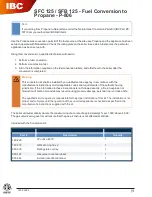
7
1-3
1
2
3
G
V
AC
AF
R
SC
M
INS
TALLER
US
ER
MAINTEN
AN
CE TECHNI
CI
AN
1.4 BOILER CONNECTION UNIT.
The connection unit, which is composed of all
the required accessories to connect the appli-
ance’s hydraulic and gas system, is furnished as
an optional kit. Execute connections as indicated
in the relative instructions sheet by using the
connections represented in fig. 1-3.
1.5 GAS CONNECTION.
Our boilers are designed to operate with methane
gas (G20) and LPG. Supply pipes must be the
same as or larger than the 3/4”G boiler fitting.
Before connecting the gas line, carefully clean
inside all the fuel feed system pipes to remove
any residue that could impair boiler efficiency.
Also make sure the gas corresponds to that for
which the boiler is prepared (see boiler data
name plate). If different, the appliance must be
converted for operation with the other type of
gas (see converting appliance for other gas types).
The dynamic gas supply (methane or LPG)
pressure must also be checked according to the
type used in the boiler, which must comply with
the technical standards in force, as insufficient
levels can reduce generator output and cause
malfunctions.
Ensure correct gas cock connection. The gas sup-
ply pipe must be suitably dimensioned according
to current regulations in order to guarantee cor-
rect gas flow rate to the burner even in conditions
of maximum generator output and to guarantee
appliance efficiency (technical specifications).
The coupling system must conform to technical
standards in force.
Fuel gas quality.
The appliance was designed
to operate with combustible gas free of impuri-
ties; otherwise it is advisable to fit special filters
upstream of the appliance to restore the purity
of the fuel.
Storage tanks (in case of supply from LPG
depot).
- New LPG storage tanks may contain residual
inert gases (nitrogen) that degrade the mixture
delivered to the appliance casing functioning
anomalies.
- Due to the composition of the LPG mixture,
layering of the mixture components may occur
during the period of storage in the tanks. This
can cause a variation in the heating power of
the mixture delivered to the appliance, with
subsequent change in its performance.
1.6 HYDRAULIC CONNECTION.
Attention:
in order not to void the condensa-
tion module warranty, before making the boiler
connections, carefully wash the heating system
(pipes, radiators, etc.) with special pickling or
descaling products to remove any deposits that
could compromise correct boiler operation.
A treatment of the heating and water system
water is required, in compliance with the tech-
nical standards in force, in order to protect the
system and the appliance from deposits (e.g.
scale), slurry or other hazardous deposits. In
order not to void the heat exchanger warranty,
you are required to comply with what has been
prescribed in paragraph 1.21.
Water connections must be made in a rational
way using the couplings on the boiler template.
Attention:
the manufacturer declines all liability
in the event of damage caused by the installation
of an automatic filling system.
In order to meet the system requirements es-
tablished by the technical regulation in force in
relation to the pollution of drinking water, we
recommend installing the IMMERGAS anti-
backflow kit to be used upstream of the cold
water inlet connection of the boiler. It is also
recommended that the heat transfer fluid (e.g.
water
+
glycol) entered in the primary circuit
of the boiler (heating circuit), complies with the
local regulations in force.
Attention:
to preserve the duration and the ef-
ficiency features of the appliance, in the presence
of water whose features can lead to the deposit of
scale, installation of the “polyphosphate dispenser”
kit is recommended.
3-bar safety valve
. Discharge of the safety valve
has been conveyed to the condensate drain trap.
Consequently, in the event of valve intervention,
the discharged liquid will end up in the sewer
system through the drainpipe of the condensate
drain trap.
In any case the lower part of the appliance is fit-
ted with a drain fitting (ref. 3 Fig. 1-3) with the
relative closure cap to check for the presence of
liquid in the discharge circuit and to check the
intervention of the 3 bar safety valve.
Condensate drain.
To drain the condensate
produced by the appliance, it is necessary to
connect to the drainage system by means of
acid condensate resistant pipes, with an internal
Ø
of at least 13 mm. The system connecting the
appliance to the drainage system must be carried
out in such a way as to prevent freezing of the
liquid contained in it. Before appliance ignition,
ensure that the condensate can be correctly re-
moved. After first ignition, check that the drain
trap is filled with condensate (para. 1.23). Also,
comply with national and local regulations on
discharging waste waters.
In the event condensate is not discharged into
the wastewater drainage system, a condensate
neutraliser must be installed to ensure compli-
ance with the parameters established by the
legislation in force.
Key:
V - Electrical connection
G - Gas supply
AC - Domestic hot water outlet
AF - Domestic cold water inlet
SC - Condensate drain (minimum internal diam-
eter Ø 13 mm)
M - System flow
R - System return
1 - System filling valve
2 - System draining valve
3 - 3-bar safety valve drain fitting signal
Summary of Contents for Victrix Maior 28 TT 1 ErP
Page 1: ...VICTRIX MAIOR 28 35 TT 1 ERP IE Instruction and recommendation booklet 1 038659ENG...
Page 2: ......
Page 49: ...49...
Page 50: ...50...
Page 51: ...51...








































